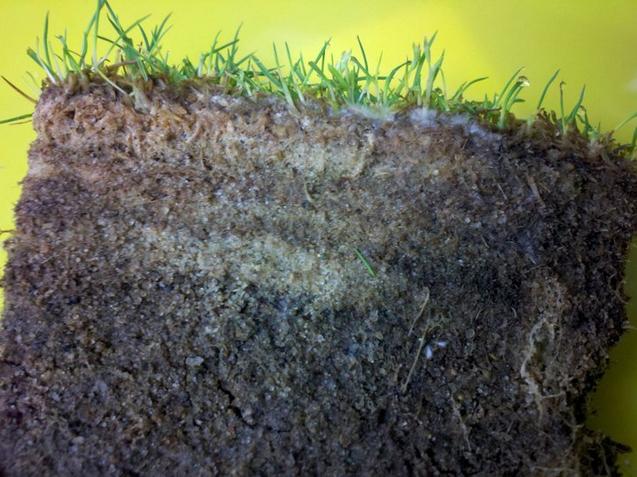'Déjà vu all over again:' Research shows 'mulch fungus' causes turfgrass disease

The white mycelium that cause thatch collapse are easily seen in this photo of a turf sample from a diseased patch. Credit: College of Agricultural Sciences, Penn State
The disease, based on the symptoms expressed on finely mown turf, has been referred to as thatch collapse. It turns out that the fungus creating the condition — which has been seen on courses in the United States, Australia, New Zealand and Scotland — is Sphaerobolus stellatus, better known as artillery or shotgun fungus.
This “basidiomycete,” which decomposes lignin in thatch, mulch and other sources of organic matter, is well known to scientists and is common in woody substrates such as bark mulch used in landscaping. But it had not been reported previously within turfgrass stands. The fungus is unique in that it can project its glebae — gobs of spores — up to several meters, hence its common name.
For John Kaminski, associate professor of turfgrass science and director of the Golf Course Turfgrass Management Program in the College of Agricultural Sciences, the discovery — to borrow a quote from baseball great Yogi Berra — “was déjà vu all over again.”
When he was an undergraduate student in Penn State's world-renowned Turfgrass Science program in the late 1990s, Kaminski interned under Donald Davis, professor of plant pathology, and Larry Kuhns, professor emeritus of ornamental horticulture. Davis is a leading artillery fungus expert and researcher.
“They had me looking at ways to get the spores off of house siding back around the time when artillery fungus became widely known for shooting them from beds of mulch and making those tough, sticky, little black marks. We just couldn't get the spores off, and to this day, removing artillery fungus spores from the walls of homes remains a problem,” Kaminski said.
“So, back in 1998, I graduated and thought I was done with this fungus problem and went to grad school for turfgrass at the University of Maryland. Then I came back to Penn State, and suddenly we started seeing this new turfgrass problem. Through our investigation, I began working with Professor Davis again, and we determined in our research that we are dealing with the same fungus — but it has moved onto golf courses.”
Thatch degradation within golf course greens and fairways can create depressed patches from the decay of organic matter in the thatch layer between the soil surface and green vegetation. Thatch collapse first appears as circular patches of dark-green turf ranging from 3 to 18 inch in diameter. Decomposing thatch within symptomatic areas displays a characteristic fawn color and emits a mushroom odor.
Researchers took measurements of thatch depth and found that, compared to the non-infested control plugs, turf infected with S. stellatus exhibited a 20 to 25 percent decrease in organic matter and thatch depth. They compared morphological aspects of fungus isolates in samples from golf courses in the United States and New Zealand and determined optimum temperatures for isolate growth and spore production. The isolates were subjected to chemical analysis and DNA sequencing to identify the fungus causing the condition.
On greens, the disease can cause serious problems, Kaminski noted, affecting the playability of a golf course.
“It is significant because patches affected by the pathogen will settle and result in a fairly significant depression that creates unpredictable ball movement on playing surfaces that are held accountable for consistency. The detrimental effects to ball roll and firmness of greens make understanding the cause and biology behind thatch collapse of importance to its management and to the industry.”
When golf course managers discover the disease, there is no known treatment to eliminate it. The Penn State research, published recently in Crop Science, is seen as the first step in developing methods to manage thatch collapse.
“Now that we have made this initial discovery and know what is causing the problem, it lays the groundwork for us to try to identify options for course control,” Kaminski said.
The condition is now a global issue for the golf industry, but no one really knows how the fungus is spread, according to Kaminski, who suggested it could be as simple as its spores just dispersing in the air.
“But the disease has made its way around the world in a fairly short period of time,” he said. “People have become aware of the problem only recently, even though it probably was around for several years before it was characterized. After we began investigating the disease and making inquiries, we have heard from more and more golf course managers saying, 'Oh yes, we've seen that.'”
###
Also involved in the research were Amy Baetsen-Young, a former master of science student in plant science, Penn State and Matthew Kasson, a scientist with West Virginia University's Division of Plant and Soil Sciences.
Penn State's Plant Science Department and the Pennsylvania Turfgrass Council supported this work.
Media Contact
All latest news from the category: Agricultural and Forestry Science
Newest articles

A new puzzle piece for string theory research
Dr. Ksenia Fedosova from the Cluster of Excellence Mathematics Münster, along with an international research team, has proven a conjecture in string theory that physicists had proposed regarding certain equations….

Climate change can cause stress in herring larvae
The occurrence of multiple stressors undermines the acclimatisation strategies of juvenile herring: If larvae are exposed to several stress factors at the same time, their ability to respond to these…

Making high-yielding rice affordable and sustainable
Plant biologists show how two genes work together to trigger embryo formation in rice. Rice is a staple food crop for more than half the world’s population, but most farmers…



